Python pip and virtualenv
After working for a couple of years with Python and external dependencies I’ve ran again and again into the same kind of problems. Bad habits Say you have a global python installation under e.g. C:\Python36 on Windows. When you start working on your first python project you want to use external packages and you encounter…




